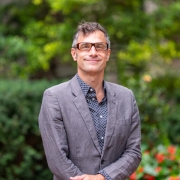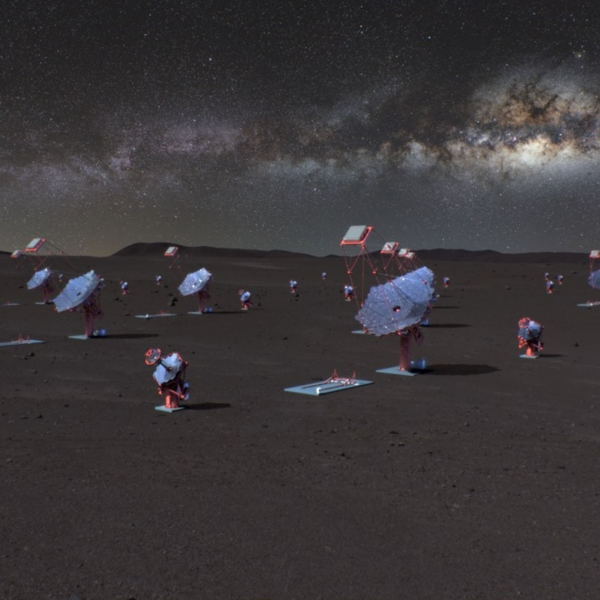The newly hired director of public scholarship talks about finding new audiences, forging connections, and becoming an expert on airports.
Christopher Schaberg is the newly hired Director of Public Scholarship for the Program in Public Scholarship (PPS). Kicking off his work in the Fall 2023 semester, Schaberg has hosted a series of workshops with faculty and grad students, as well as social events to connect WashU leaders across different disciplines. Prior to his arrival at WashU, Schaberg was the Dorothy Harrell Brown Distinguished Professor of English and Director of the Center for Editing & Publishing at Loyola University New Orleans.
A signature initiative of the Arts & Sciences Strategic Plan, PPS works toward translating the often complex and highly specialized expertise of WashU scholars for broader, public audiences. We asked Schaberg about what the program is up to in his first semester on the job, and where he anticipates it growing from here.
How did your years of teaching workshops in writing and editing help to prepare you for your role as Director of Public Scholarship?

Running workshops at various universities over the past six years or so, I learned how to clearly explain the opportunities and challenges of public scholarship to a wide range of academics. Working with scholars from across disciplines—from biologists and geographers to historians and philosophers—and at different stages of their careers, I also learned that it’s never a one-size-fits-all situation. It sounds obvious, but it’s important to realize that scholars are working on different projects (of type and scale) at different points in their careers, and each kind of project lends itself to a particular form of public engagement, and a specific audience. Whether we aim for an online essay, a trade book, a podcast appearance, or a community event depends on seeing each scholar and each project as having unique potential for public engagement.
Now that you’ve led a few Program in Public Scholarship workshops here at WashU, what types of feedback are you hearing from the faculty and grad students who have participated? What challenges do they have in common?
There is a tremendous appetite for this work here at WashU. Nearly everyone I’ve met with understands the professional value and tactical advantages of doing public scholarship. By professional value, I mean that faculty and graduate students increasingly recognize that their departments and disciplinary leaders appreciate this work: public impact is a metric for assessing how research travels in the world. By tactical advantages, I mean how faculty and graduate students can use public scholarship to advance their research and creative goals, whether that means applying for a fellowship, getting a book contract, or generating wide interest in a project in its nascent stages. The responses to our workshops have been overwhelmingly positive and encouraging, and the feedback I have received has generated spinoff ideas for future workshops. This is a promising sign! But the challenges are real, too: There are risks in doing public scholarship, a topic that we’ll take on directly in an upcoming workshop.
The work of PPS ties in closely with the Arts & Sciences Strategic Plan pillar of forging connections between the academy and society. How do you work with faculty members to translate the intricacies of their expertise and research to the world beyond WashU’s walls? What sorts of tools do you want to provide them?
I mentioned audience above, and I think it’s one of the most important lessons I try to teach that makes this pillar plain. In short, when academics are doing their work in strictly academic ways, they don’t really have to think about audience—because it is a given. In an academic career, you can often assume the target group with whom you are communicating: your mentors, your colleagues, your students, or peer experts in your field. But these are narrow and basically known audiences. Doing public scholarship is a matter of tuning into different and broader audiences, building bridges between the academy and society. Once we identify an audience beyond campus that can benefit from our scholarly work in one way or another, then we can determine what form of engagement or communication best suits that audience. Really the heart of our program is working with faculty and graduate students one-on-one to figure this out, and help each project take shape in the world—to find a new audience. I envision a toolbox that grows over time, as more scholars at WashU utilize our program and further possibilities for public engagement appear.
I do have to ask how you became one of the nation’s leading experts on airports and air travel. Was that a subject interest that you fell into unexpectedly, or has it been a lifelong fascination?
The simple two-part answer is that I worked at an airport while I was earning my Master’s degree (and this was when 9/11 happened, so it was an interesting time, to say the least), and then I wrote a dissertation about airports in American literature and culture for my PhD. But funnily enough, this latter work produced my first encounter with public scholarship: In 2006, as I was working on my dissertation at UC Davis, I received an email out of the blue from the director of the Sacramento Metropolitan Arts Commission. They were about to select public artworks for the under-development new Terminal B of the Sacramento airport, and someone had learned about my dissertation research. They asked me to come present my findings to the committee, and I remember being both delighted and completely bewildered. My “findings”? I was just writing a dorky tome of literary and cultural theory! But then I realized I had all sorts of real-world insights I could share, and I enjoyed putting together a slideshow for the group and talking with them about the aesthetic potentials and pragmatic implications of airport spaces. In hindsight, this experience planted a seed for what grew into my strong belief in public scholarship.
What does success look like for the first year of PPS? How do you want to see the program grow in the future?
Success for the Program in Public Scholarship looks like an expanding number of faculty and graduate students utilizing our workshops and collaborating with us on both big events and focused projects. I’m excited for the inaugural A&S CREATES Graduate Cohort in Arts & Sciences, commencing next fall, which will be themed around Public Scholarship. This is an opportunity for us to create a groundswell of transdisciplinary interest in public scholarship, at the level of emerging talent. I also foresee the Program developing an original publishing outlet of some sort—a signature media platform that we can use to give our faculty and graduate students hands-on, direct experience with public scholarship. Usually, when a scholar has success with reaching a bigger audience, it has a motivating and generative effect. I want to see our successes branch out and multiply, doing justice to the academic rigor and forward-looking vision for which WashU is known. Success also means our Program becoming a model for how to support public scholarship at the institutional level—serving as a model for other forward-looking institutions, near and far.




